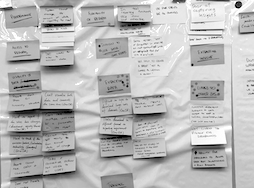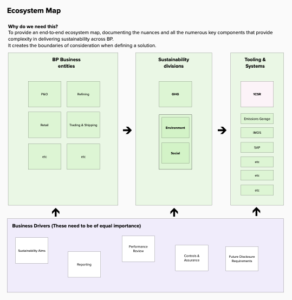A Discovery & Research Case Study
The client
A leading global energy company, committed to driving the transition towards a more sustainable energy future.
The challenge The energy company faces significant challenges in collecting and managing the vast amounts of global sustainability data required for reporting and meaningful decision-making. Environmental, Social and GHG data was scattered across multiple paper-based and digital systems, inconsistent in quality, and difficult to analyze for strategic purposes.
The energy company faces significant challenges in collecting and managing the vast amounts of global sustainability data required for reporting and meaningful decision-making. Environmental, Social and GHG data was scattered across multiple paper-based and digital systems, inconsistent in quality, and difficult to analyze for strategic purposes.
This led to inefficient and time-consuming sustainability reporting and hindered the ability to track progress toward sustainability effectively. The company needed a streamlined, transparent, and cohesive vision and strategy towards activity and data management to enhance both internal accountability and external reporting.
The approach
Our research and discovery approach first focused on understanding the current data management workflow and identifying pain points across different levels of the data collectors and data managers—from field operators to sustainability managers, business leaders and external stakeholders.
Secondly, discovering how a comprehensive sustainability management system could unlock stakeholder and c-suite members to consume the data to take action internally and externally with government officials.
It looked like:
- Research & Insights with in-field users:
-
 Conducted in-depth user interviews and workshops with employees across departments to map out experiences, user & business goals, needs, data flows and identify key challenges in capturing sustainability data accurately. [the as-is]
Conducted in-depth user interviews and workshops with employees across departments to map out experiences, user & business goals, needs, data flows and identify key challenges in capturing sustainability data accurately. [the as-is]- Performed an analysis of technical data systems, highlighting inconsistencies, unintended consequences, manual processes, and lack of real-time data visibility.
- Outputs: Customer and data journeys, pain points, user quotes, personas, insights, tooling/tech, experience principles and opportunities.
-
Research & Insights with business stakeholders:

Conducted in-depth interviews and workshops with sustainability data consumers and stakeholders to explore user needs and requirements for accessible, actionable sustainability insights.
- Performed gap analysis of as-is against intended outcomes.
- Reviewed existing and future regulatory requirements, corporate responsibility goals, and the needs for a future-state.
- Captured individual vision statements regarding the service design, to progress towards social, environment and GHG sustainable experiences, decisions and reporting needs.
- Outputs: Data consumption journeys, pain points, user quotes, personas, business value drivers and metrics, service ecosystem map, sustainability aspirations, experience principles and opportunities.
🌶️ Key Findings
- Significant opportunities to advance sustainability actions within the business. This would help the business advance market expectations and push the global sustainability agenda.
- The reliance on manual data gathering in-field, introduced considerable errors and inconsistencies. Data integrity was a key pain point. Tools and systems were not integrated and using different measurement tactics.
- User and team member moral was low, due to several unintended consequences.
- Key sustainability contributors raised concerns over reliability, leading to significant loss of trust in effort.
- Regulatory reporting requirements evolves quick, the inefficient ways of working reduced agility to respond.

The outcome
- Shaping the sustainability vision
- Co-created the future vision for Sustainability Reporting. It captured user, process and business opportunities to advance sustainability practices.
- Getting the basics right: The implementation plan was a phased approach, first unifying data, streamlining reporting processes and aligning jobs to be done; allowing experts to invest time on impactful tasks.
- Scaling: Secondly, extending the research and service discovery end-to end. This means to front-line data gatherers, all the way through VP decision makers, designing to deliver on the experience principles and value drivers. The mission needs to serve as a centralized solution for all sustainability data, offering transparency, flexibility, and robust reporting capabilities. This will improve cross-departmental collaboration, regardless if focused on GHG, Environment or Social Sustainability.
For more information, get in touch

